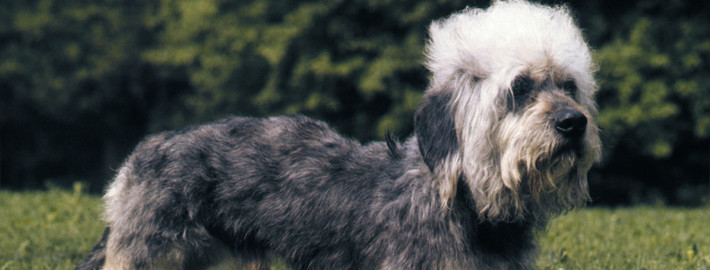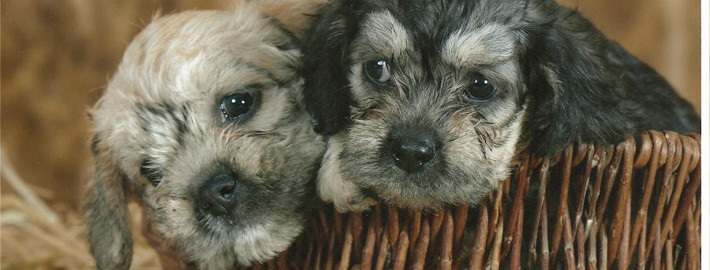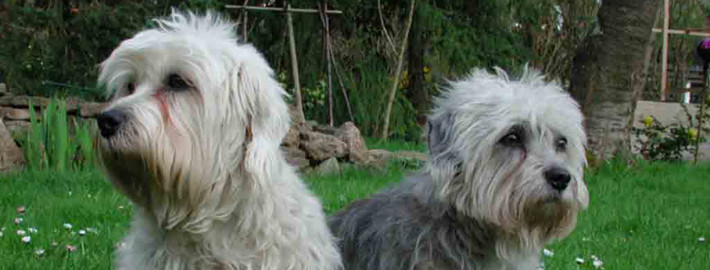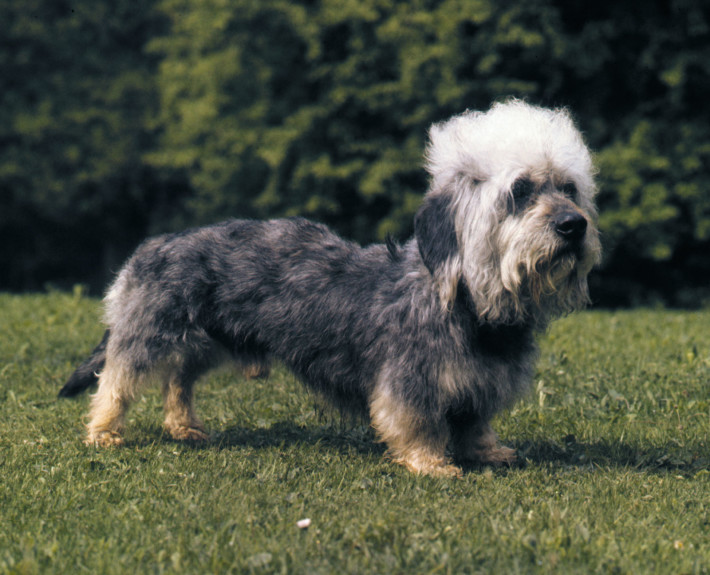What makes the Dandie Dinmont Terrier Unique?
Unlike the prototypical terrier, the Dandie is made up of a series of curves, topped off with a long, scimitar-shaped tail. It is almost twice as long as tall, constructed to go to ground after tough quarry. Its hind legs are definitely longer than its front legs. Its gait is free and easy. It has a distinctive coat made up of about two-thirds hardish (not wiry) hair and one-third soft hair, about 2 inches in length. The head is covered with soft, silky hair, lending to the appearance of a large head. The topknot also enhances the expression, which is determined, dignified, soft and wise. The Dandie Dinmont is no “dandified” dog; it is rough-and-tumble and ready for the hunt. Yet it functions well as a dignified house pet, affectionate but not doting. It is a loyal companion suitable for people of all ages, but it does need daily exercise to keep it from becoming frustrated. It is intelligent and very independent. It tends to be reserved with strangers and aggressive toward strange dogs. Some dig.
Breed Groups
Page Contents
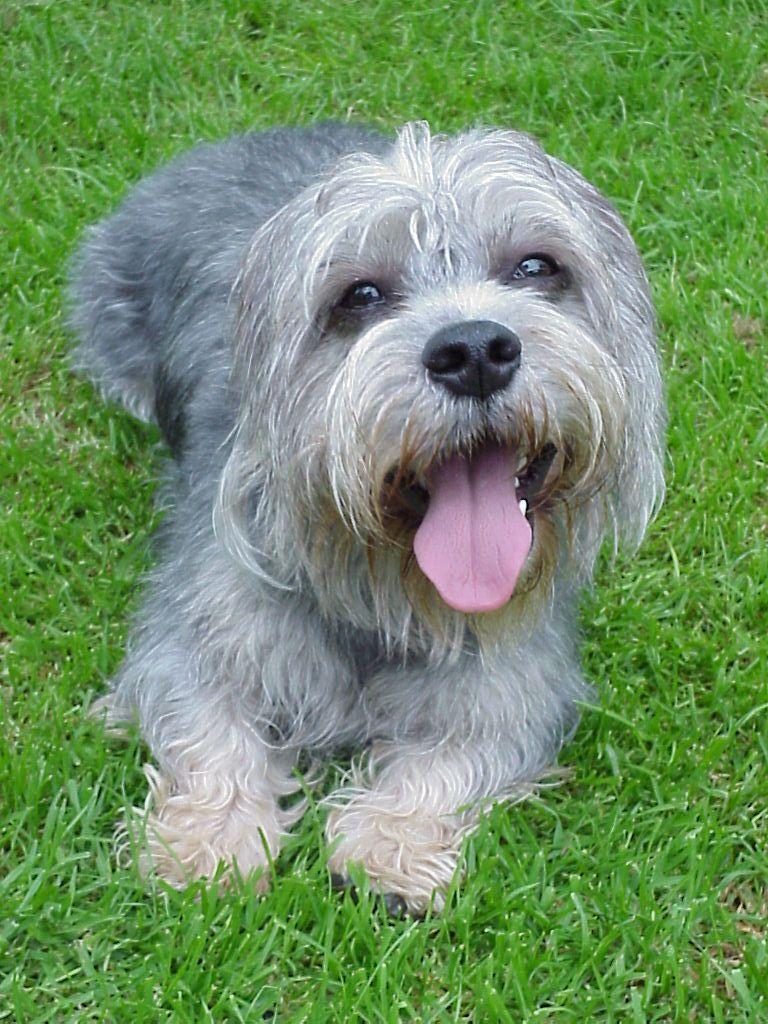
Is the Dandie Dinmont Terrier Right For You?
Dandie is made up of a series of curves, topped off with a long, scimitar-shaped tail. It is almost twice as long as tall, constructed to go to ground after tough quarry. Its hind legs are definitely longer than its front legs. Its gait is free and easy. It has a distinctive coat made up of about two-thirds hardish (not wiry) hair and one-third soft hair, about 2 inches in length. The head is covered with soft, silky hair, lending to the appearance of a large head. The topknot also enhances the expression, which is determined, dignified, soft and wise. The Dandie Dinmont is no “dandified” dog; it is rough-and-tumble and ready for the hunt. Yet it functions well as a dignified house pet, affectionate but not doting. It is a loyal companion suitable for people of all ages, but it does need daily exercise to keep it from becoming frustrated. It is intelligent and very independent.
In 5 Words
- Lovely
- Fun-Loving
- Companionable
- Determined
- Affectionate
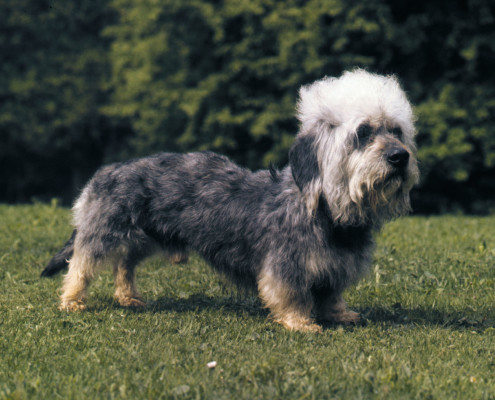
Characteristics
Learn About the Dandie Dinmont Terrier
Description
The Dandie Dinmont Terrier is a low to the ground, longer than he is tall, little dog. The large head has a topknot that is in proportion to the body. The skull is broad between the ears, gradually tapering to the eyes. The muzzle is deep, with a well-defined stop. The large teeth meet in a scissors bite. The moderately large nose and the lips are dark in color. The large, round, wide-set eyes come in dark hazel with dark eye rims. The 3 to 4 inch (7-10 cm) ears are pendant, set low and wide, hanging close to the cheeks. The legs are short with the back legs being a little longer than the front legs. The “scimitar” tail looks like a curved sword and is about 8 to 10 inches (20-25 cm) long, thicker for about 4 inches then tapering to a point.
The head is covered with soft, silky hair, lending to the appearance of a large head. The topknot also enhances the expression, which is determined, dignified, soft and wise. The Dandie Dinmont is no “dandified” dog; it is rough-and-tumble and ready for the hunt. Yet it functions well as a dignified house pet, affectionate but not doting. It is a loyal companion suitable for people of all ages, but it does need daily exercise to keep it from becoming frustrated. The tail is carried up when alert and relaxed when the dog is. The fur is double with a first fluffy and soft coating and an external coating with harsher hair on the back and softer in the inner side of the body. Colours can be “pepper” (which varies from black to silver- light gray) and “mustard” (a reddish brown to pale beige).
Short History of the Dandie Dinmont Terrier
The Dandie Dinmont terrier stands out as a most unusual terrier in appearance, yet her roots are as quintessentially terrier as any. She first appeared as a distinct type of terrier in the 18th century around the border country of Scotland and England. Here they were owned by farmers and gypsies and valued for drawing and killing otters, badgers and foxes. At one time, they were known as Catcleugh, Hindlee or pepper and mustard terriers. The most well-known of these dogs were owned by James Davidson, who named almost all his dogs either Pepper or Mustard along with some identifying adjective.
The Dandie Dinmont Terrier originated from the border regions between Scotland and England known as the Cheviot Hills during the 1600′s. Bred to hunt badgers, they were also skillful in hunting vermin, rabbit and otter. Several theories exist as to the origin of the Dandie, one of the most popular being that a cross between an Otterhound and some type of terrier produced the earliest examples of the breed. The hound-like ears of the breed and its exceptionally deep and loud bark are additional factors that lend credence to this theory. First noted as a distinct breed about 1700, it was later named after a character created by Sir Walter Scott in his novel Guy Mannering(1815).
The Brittish Dandie Dinmont Terrier Club was formed in 1875, and swiftly wrote a breed standard. The American Kennel Club admitted the Dandie Dinmont into its Terrier Group shortly thereafter in 1886 (the AKC was only founded in 1884). The modern Dandie Dinmont is known as the “gentleman of the terrier family.” The dog’s small size and big personality made it a natural choice for bringing to America, and the dogs earned their keep during trans-Atlantic passages by killing rats and entertaining the crew. The American Kennel Club recognized the breed in 1886, just two years after the club itself was founded.
Temperament
The Dandie Dinmont Terriers are independent, lively, and affectionate towards their owners. They are friendly, but not always obedient. They can be independent, and are happiest when busy. They have quite a docile and peaceful attitude for terriers. They are bold, unafraid, but not instigating in fights. They remain dignified, even in play. They are very loyal, and can be used as a guard dog. . He shows incredible loyalty to his owner, and is utterly devoted to his family. He is affectionate and loves to cuddle and be held in his owner’s arms. He will follow you all over the house. They like to be number one in the household, and sometimes their love can turn into jealousy. They don’t always do well with other dogs in the house, especially those of the same sex. They don’t pick fights with other dogs, but they will stand their ground if someone else starts it. They usually do well with cats in the house, but they might chase your neighbor’s cat. They make great watchdogs and have a loud, surprisingly deep bark. However, they are quiet in the house, and save their bark for when it matters. As soon as the humans take the control away from the dog, and the dog’s instincts are met, the negative behaviors will begin to subside and the Dandie Dinmont will be a wonderful, trustworthy family companion.
Caring for Your Dandie Dinmont Terrier
General Health
Allergies (which cause itchy skin and can lead to bacterial skin infections called pyoderma) are very common in all terriers.
Orthopedic diseases should be expected because of the breed’s deformed chondrodysplastic build. The most common orthopedic diseases are intervertebral disk disease, hip dysplasia, and luxating patella (loose knees). Luxating shoulder can also occur. Though the Orthopedic Foundation of America has evaluated the hip X-rays of only 32 Dandie Dinmonts, 50% were dysplastic. This is very bad and the true rate is even higher because most of the obviously bad X-rays were not sent in for official evaluation.
Portosystemic shunt (an abnormality of the blood circulation, resulting in blood from the heart bypassing the liver and entering the general circulation, causing toxic encephalitis).
Urolithiasis (urate stones)
Intervertebral disc disease
Glaucoma
Epilepsy
primary lens luxation.
Corneal ulceration is the loss of the corneal epithelium (the outermost cells of the cornea).
Dandie’s are also prone to ear infections.
Intervertebral disk disease (IVDD) is a disorder that affects the spinal disks resulting in pain, difficulty walking and possibly paralysis.
Grooming & Bathing
The Dandie Dinmont needs to be brushed regularly. They should have professional grooming. Dead hair should be plucked out once or twice a year. Show dogs require much more grooming. This breed sheds little to no hair. Dandie Dinmont Terrier puppy for a walk on daily basis. Her teeth should be brushed at least twice a week with toothpaste and toothbrush designed for dogs. Brushing removes the accumulation of plaque and tartar which can cause cavities (rarely) and periodontal disease. Her toenails may need to be examined for growth and clipped regularly.
The toenails of the rear feet grow slower than the toenails of the front feet. . The coat needs to be brushed at least 3-4 times a week and should also be stripped twice in a year to maintain a healthy looking coat. It should be bathed only when necessary and must be dried properly after each bath. The eyes and ears of the dog should be cleaned properly. Its nail and the hair around eyes, ears and paws should be trimmed properly. Its beard should be cleaned daily to remove any food remains.
Exercise & Training
The Dandie enjoys the chance to hunt around and explore in a safe area and needs a moderate walk to stay in condition. It does best as an indoor/outdoor dog, and should sleep inside.


